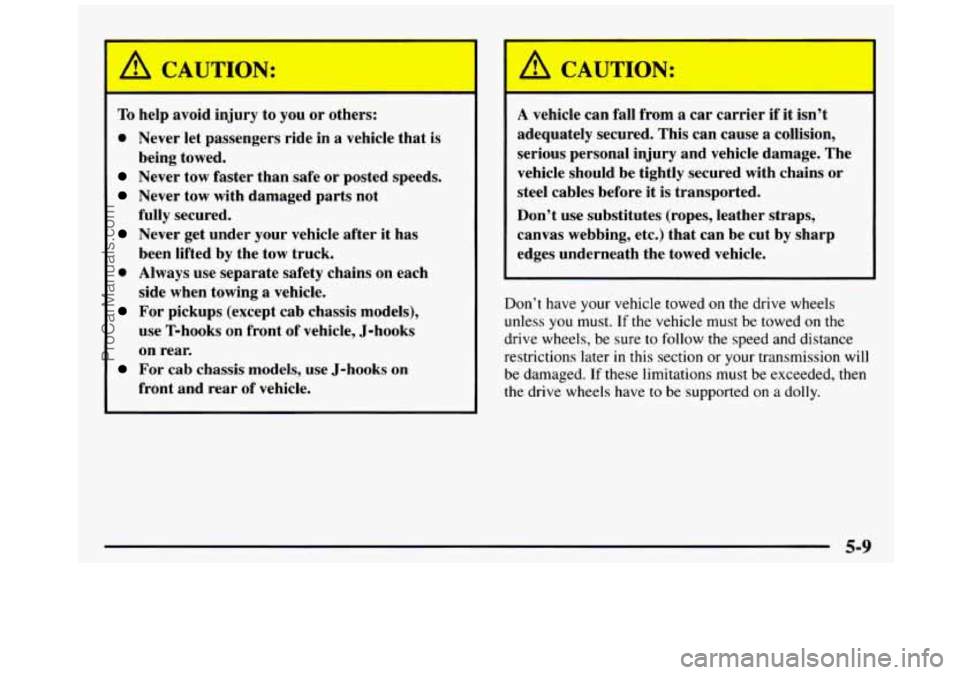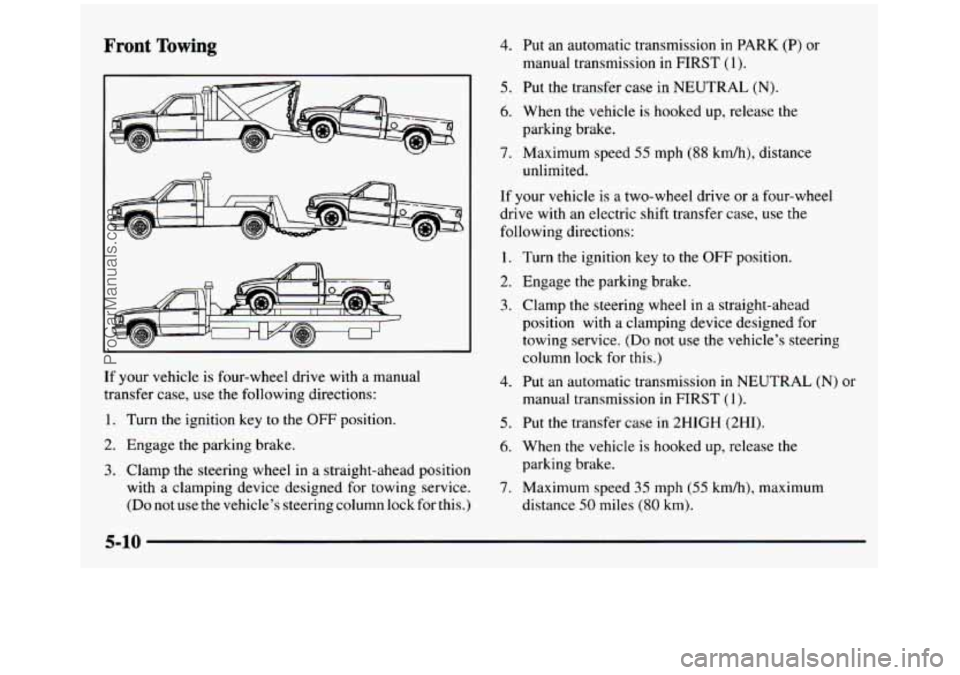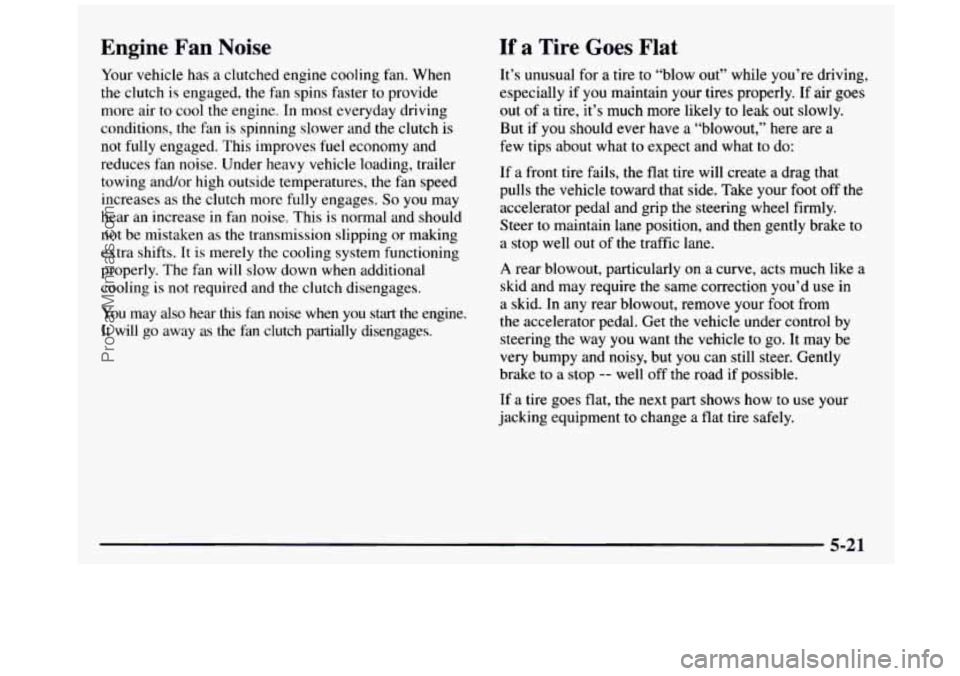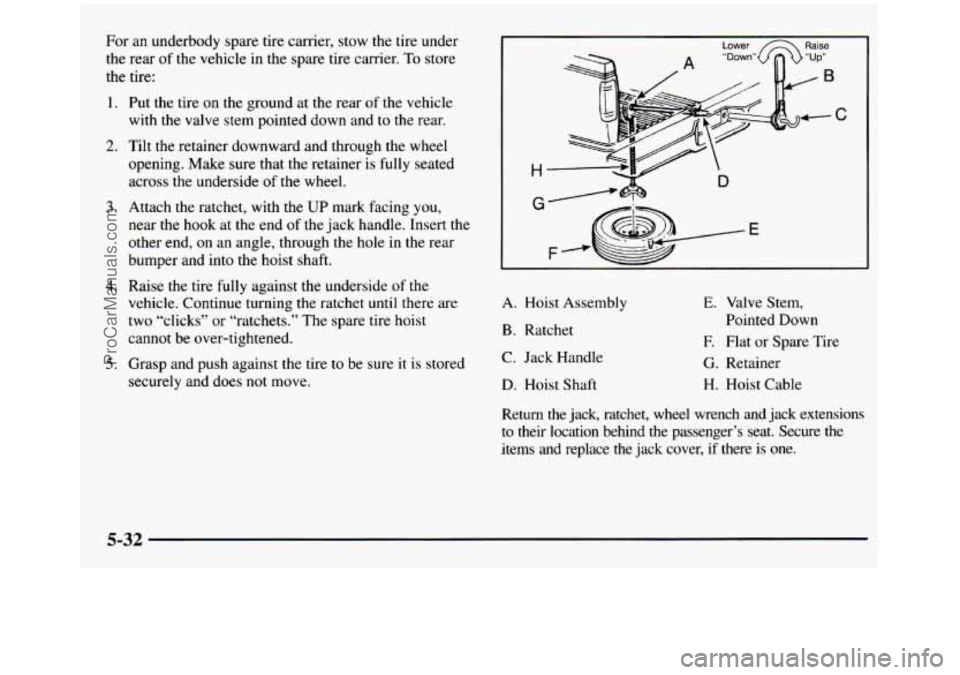Page 248 of 436

10. Try to start the vehicle with the dead battery.
If it won’t start after a few tries, it probably
needs service.
11. Remove the cables in reverse order to prevent
electrical shorting. Take care that they don’t touch
each other or any other metal.
A. Heavy Metal Engine Part
B. Good Battery
C. Dead Battery
Towing Your Vehicle
Try to have your GM dealer or a professional towing
service tow your vehicle. See “Roadside Assistance”
in
the Index.
If your vehicle has been changed since it was
factory-new, by adding such things as fog lamps, aero
skirting, or special tires and wheels, these instructions
may not be correct.
Before you do anything, turn on the hazard
warning flashers.
When you call, tell the towing service:
0 That your vehicle has rear-wheel drive, or that it has
the four-wheel-drive option.
0 The make, model and year of your vehicle.
0 Whether you can move the shift lever for the
0 If there was an accident, what was damaged.
transmission and transfer
case, if you have one.
When the towing service arrives, let the tow operator
know that this manual contains detailed towing
instructions and illustrations. The operator may want to
see them.
5-8
ProCarManuals.com
Page 249 of 436

I A CAUTION:
To help avoid injury to you or others:
0 Never let passengers ride in a vehicle that is
Never tow faster than safe or posted speeds.
Never tow with damaged parts not
fully secured.
Never get under your vehicle after it has
been lifted by the tow truck.
0 Always use separate safety chains on each
side when towing a vehicle.
For pickups (except cab chassis models),
use T-hooks on front of vehicle, J-hooks
on rear.
front and rear
of vehicle.
being
towed.
For cab chassis models, use J-hooks on
I [ CAUTION:
t
A vehicle can fall from a car carrier if it isn’t
adequately secured. This can cause a collision,
serious personal injury and vehicle damage. The
vehicle should be tightly secured with chains or
steel cables before
it is transported.
Don’t use substitutes (ropes, leather straps,
canvas webbing, etc.) that can be cut by sharp
edges underneath the towed vehicle.
Don’t have your vehicle towed
on the drive wheels
unless
you must. If the vehicle must be towed on the
drive wheels, be sure
to follow the speed and distance
restrictions later
in this section or your transmission will
be damaged.
If these limitations must be exceeded, then
the drive wheels have
to be supported on a dolly.
5-9
ProCarManuals.com
Page 250 of 436

Front Towing 4. Put an automatic transmission in PARK (P) or
manual transmission in FIRST
(1).
5. Put the transfer case in NEUTRAL (N).
6. When the vehicle is hooked up, release the
7. Maximum speed 55 mph (88 kmh), distance
If your vehicle is a two-wheel drive or a four-wheel
drive with an electric shift transfer case,
use the
following directions: parking brake.
unlimited.
1.
2.
3.
If your vehicle is four-wheel drive with a manual transfer case, use the following directions:
1. Turn the ignition key to the OFF position.
2. Engage the parking brake.
3. Clamp the steering wheel in a straight-ahead position
with a clamping device designed for towing service.
(Do not use the vehicle’s steering column lock for this.)
4.
5.
6.
7.
Turn the ignition key to the OFF position.
Engage the parking brake.
Clamp the steering wheel in a straight-ahead
position with
a clamping device designed for
towing service.
(Do not use the vehicle’s steering
column lock
for this.)
Put an automatic transmission
in NEUTRAL (N) or
manual transmission in FIRST (1).
Put the transfer case
in 2HIGH (2HI).
When
the vehicle is hooked up, release the
parking brake.
Maximum speed
35 mph (55 km/h), maximum
distance
50 miles (80 km).
5-10
ProCarManuals.com
Page 251 of 436
Rear Towing
I NOTICE:
If your vehicle is equipped with a manual or
electric shift transfer
case, a towing dolly must be
used under the front wheels or vehicldpowertrain
damage
will occur.
NOTICE:
Towing pickup models from the rear while loaded
with heavy cargo may cause the frame side rails
to flex sufficiently
to allow the pickup box to
contact the cab and could cause damage to the
cab and/or box.
Engine Overheating (Gasoline Engine)
You will find a coolant temperature gage on your
vehicle’s instrument panel.
If your vehicle has a diesel engine, see “Engine
Overheating” in the Diesel Engine Supplement.
5-11
ProCarManuals.com
Page 252 of 436

I
If Steam Is Coming From Your Engine
I A CAUTION:
Steam from an overheated engine can burn you
badly, even if you just open the hood. Stay away
from the engine
if you see or hear steam coming
from it. Just turn it
off and get everyone away
from the vehicle until it cools down. Wait until
there is no sign of steam or coolant before you
open the hood.
CAUTION: (Continued) tin
If you
keep driving when your engine is
overheated, the liquids in it can catch fire. You or
others could be badly burned. Stop your engine if
it overheats, and get out of the vehicle until the
engine is cool.
I NOTICE:
If your engine catches fire because you keep
driving with no coolant, your vehicle can be
badly damaged. The costly repairs would not be
covered by your warranty.
If No Steam Is Coming From Your Engine
If you get the overheat warning but see or hear no
steam, the problem may not be
too serious. Sometimes
the engine can get a little too hot when
you:
0 Climb a long hill on a hot day.
0 Stop after high-speed driving.
0 Idle for long periods in traffic.
0 Tow a trailer. See “Driving on Grades” in the Index.
ProCarManuals.com
Page 261 of 436

Engine Fan Noise
Your vehicle has a clutched engine cooling fan. When
the clutch is engaged, the fan spi.ns faster to provide
more air
to cool the engine. In most everyday driving
conditions, the fan is spinning slower and the clutch is
not fully engaged. This improves
fuel economy and
reduces fan noise. Under heavy vehicle loading, trailer towing and/or high outside temperatures, the fan speed
increases as the clutch more fully engages.
So you may
hear an increase in fan noise. This
is normal and should
not be mistaken as the transmission slipping or making
extra shifts. It is merely the cooling system functioning
properly. The fan will slow down when additional
cooling is not required and the clutch disengages.
You may also hear this
fan noise when you start the engine.
It will
go away as the fan clutch partially disengages.
If a Tire Goes Flat
It’s unusual for a tire to “blow out” while you’re driving,
especially
if you maintain your tires properly. If air goes
out
of a tire, it’s much more likely to leak out slowly.
But if you should ever have
a “blowout,” here are a
few tips about what to expect and what to do:
If a front tire fails, the flat tire will create a drag that
pulls the vehicle toward that side. Take your foot off the
accelerator pedal and grip the steering wheel firmly.
Steer to maintain lane position, and then gently brake to
a stop well out of the traffic lane.
A rear blowout, particularly on a curve, acts much like a
skid and may require the same correction you’d use in
a skid. In any rear blowout, remove your foot from
the accelerator pedal. Get the vehicle under control by
steering the way you want the vehicle to go. It may be
very bumpy and noisy, but
you can still steer. Gently
brake
to a stop -- well off the road if possible.
If a tire goes flat, the next part shows how to
use your
jacking equipment
to change a flat tire safely.
ProCarManuals.com
Page 269 of 436
I a CAUTION:
Rust or dirt on the wheel, or on the parts to
which it is fastened, can make the wheel nuts
become loose after
a time. The wheel could come
off and cause an accident. When you change a
wheel, remove any rust or dirt from the places
where the wheel attaches to the vehicle. In an
emergency, you can use a cloth or a paper towel
to do this; but be sure to use a scraper or wire
brush later, if you need to, to get
all the rust or
dirt
off.
b, CAUTION:
Never use oil or grease on studs or nuts. If you
do, the nuts might come loose. Your wheel could
fall
off, causing a serious accident.
6. Replace the wheel nuts
with the rounded end
of the nuts toward the
wheel. Tighten each wheel
nut by hand using
the wheel wrench until
the wheel is held against
the hub.
5-29
ProCarManuals.com
Page 272 of 436

For an underbody spare tire carrier, stow the tire under
the rear
of the vehicle in the spare tire carrier. To store
the tire:
1.
2.
3.
4.
5.
Put the tire on the ground at the rear of the vehicle
with the valve stem pointed down and
to the rear.
Tilt
the retainer downward and through the wheel
opening. Make sure that the retainer
is fully seated
across the underside of the wheel.
Attach the ratchet, with the
UP mark facing you,
near the hook at the end
of the jack handle. Insert the
other end, on an angle, through
the hole in the rear
bumper and into the hoist shaft.
Raise the tire fully against the underside
of the
vehicle. Continue turning the ratchet
until there are
two “clicks” or “ratchets.” The spare tire hoist
cannot be over-tightened.
Grasp and push against the tire to be sure it is stored
securely and does not move.
I Lower Raise
H
r-
F- e>&
E
A. Hoist Assembly
B. Ratchet
C. Jack Handle
D. Hoist Shaft
E. Valve Stem,
Pointed Down
E Flat or Spare Tire
G. Retainer
H. Hoist Cable
Return
the jack, ratchet, wheel wrench and jack extensions
to their location behind the passenger’s seat. Secure the
items and replace the jack cover, if there
is one.
5-32
ProCarManuals.com